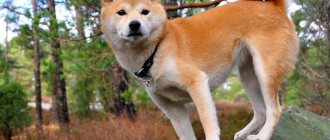Pomeranian puppies are adorable, furry creatures that can often be seen on TV or in photographs.
Small sizes, a touching muzzle and soft, fluffy fur, which makes babies of this breed look like soft toys, cannot but evoke a feeling of delight.
It is not surprising that many people, having only once seen such dogs in a photograph, rushed to get such a cute puppy as soon as possible.
However, before deciding to purchase such a pet, you need to carefully familiarize yourself with the features of choosing a Pomeranian and caring for it.
How many puppies are there in the litter?
Most girls of this breed do not have multiple births, so the average litter size for Pomeranians is 2-3 babies.
The size of the litter largely depends on the size of the bitch.
If the girl is small, weighing approximately 2-2.5 kg, then she will most likely give birth to small or medium-sized litters of puppies.
A larger dog can give birth to 4-6 puppies.
What do newborns look like and when do they open their eyes?
Newborn Pomeranian puppies don't look much like those fluffy babies in advertising pictures. They are born completely blind and deaf, with a body covered with rather sparse and very short hair.
Babies at this age look disproportionate and not nearly as attractive . Their head is large and slightly flattened, their body is elongated, their legs and tails are relatively short, and their bellies are voluminous.
Pomeranians begin to see the light approximately 10-15 days after they are born..
What not to do
During the period when the Spitz begins to shed, water procedures are prohibited. Bathing will lead to matting of the fur and the formation of tangles, which are almost impossible to comb through.
It is also prohibited to cut oranges. In the future, this threatens thinning of the guard hair and baldness of the pet.
How it develops from 1 to 12 months
| Puppy age | Description of the stage of growing up | Sizes (medium, for standard size puppies) | Weight (k - dwarf, m - mini, s - standard) |
| 1 month | From about the third week, small Spitz dogs begin to cut their teeth. At this time, puppies behave restlessly, often bark and try to chew everything. Closer to the second month, the main traits of character and temperament are formed. During this time, it is very important that babies interact with other dogs and people. | 7-12 cm | k - 210-275 g m - 325-370 g s - 460-490 g |
| 2 months | The puppy begins to acquire a characteristic appearance: its coat lengthens and becomes fluffier, however, it does not reach the same density and length as in adult dogs. | up to 14 cm | k - 320-460 g m - 550-620 g s - 680-770 g |
| 3 months | The puppy's fur is gradually beginning to be replaced by the adult's, however, at this age the shedding is not yet too noticeable. The babies look like those adorable fluffy puppies from advertising photos. And at this time it is already possible to determine with greater or lesser probability what color they will have. | up to 16 cm | k - 460-690 g m - 800-920 g s - 1.0-1.15 kg |
| 4 months | Little Pomeranians' teeth change and they begin to shed more frequently. Most puppies at this age do not look as attractive as before: almost all of their baby hair has already come out, and their adult hair has not grown back properly. | up to 17 cm | k - 600-880 g m - 1.0-1.175 kg s - 1.3-1.45 kg |
| 5 months | Puppies continue to shed, but by this age some of them already have enough hair to look almost as attractive as when they were young. | up to 18 cm | k - 700-1030 g m - 1.2 - 1.35 kg s - 1.55-1.7 kg |
| 6-9 months | Shedding continues until about 7-9 months, but in some Spitz dogs it is more pronounced, in others less. By 7 months, baby teeth should be replaced by permanent teeth. And at about 7-9 months the first heat occurs in girls of this breed. | 18-20 | k - 770-1150 g m - 1.3-1.5 kg s - 1.7-1.9 kg |
| 12 months | By this age, the Pomeranian will shed again, but its coat will acquire its final appearance and texture by the age of three. | 18-22 | k - 1.0-1.4 kg m - 1.7 - 1.9 kg s - 2.1-2.3 kg |
| Adult | The dog has reached its final physical development and is in the prime of life and beauty. | 18-22 | k - 1.0-1.4 kg m - 1.7 - 1.9 kg s - 2.1-2.3 kg |
Similar breeds
Italian Volpino are relatives of Pomeranians, but slightly larger, and come in only two monocolors: white and red.
Schipperkes are Pom-like, black shepherds that grow to the size of a small Spitz.
Alaskan Klee Kai is a small-sized decorative husky; mini individuals have the same thick fur as oranges.
Similar in appearance, but large: American Eskimo, Japanese Spitz, Eurasier, Samoyed, Alaskan Malamute, Finnish and Swedish Lapphund.
German Spitz and Pomeranian - differences
In Russia these names are synonyms, in America and Canada they are different breeds. But even in our country, classic “Germans” differ in appearance from Pomeranians.
| Pomeranian Spitz | German Spitz | |
| Height | often - miniature and small, rarely - medium, never - large | up to 35 cm |
| Wool | “cotton”, stuffed, with very thick undercoat | there is more guard hair in the skin than down hair |
| Shedding | adults hardly shed with weekly brushing | they shed anyway |
| Head | short, clear stop, ears set wide apart | elongated, “fox-like”, flattened stop, ears set narrowly |
| Teeth | missing teeth are allowed | have all teeth (42) |
| Tail | does not form rings | rings and double twisting are allowed |
Miniature Spitz: how is it different from the Pomeranian?
The Miniature Spitz is a tall variety of Spitz (18 - 22 cm at the withers). Pomeranians are simply a subspecies of miniatures (according to FCI and RKF) or a separate breed of sizes 18 - 28 cm (according to AKC). That is, these terms are synonymous unless we are talking about imported dogs of American, Canadian, or English origin (the latter are larger than the “miniature” size).
Small German Spitz and Pomeranian Spitz - differences
The Small German Spitz, or Kleinspitz, grows up to 29 cm at the withers. For Pomeranians (except for dogs of American and Canadian breeding) this is too big.
Difference between Pomeranian and Spitz?
Spitz is a whole group of dog breeds, similar in appearance, but differing in size, some proportions and purpose. The Pomeranian Spitz belongs to the smallest variety - the Miniature Spitz.
To what age do they grow?
Pomeranians belonging to different lines grow differently: some puppies are fully grown at 4-5 months, while others continue to gain height up to 9 months.
At the same time, in bitches, with the onset of the first emptying, growth may slow down or stop.
On average, Pomeranian puppies grow up to 6 months.
How to care?
Considering that Spitz fur needs regular combing and sometimes grooming, it is advisable to start accustoming your pet to these procedures as early as possible.
The baby needs to be combed with a wide-toothed comb for 10-15 minutes a day so that he gets used to grooming..
Small puppies should not be bathed too often, and it is very important to dry the coat thoroughly with a hairdryer after washing.
Also, from the very first day, the baby begins to be accustomed to a tray or diaper. To do this, you need to take it there every time after eating or sleeping.
Puppies' nails are trimmed often, as they grow faster than in adult dogs . At the same time, it is very important to carry out this procedure without coercion and, if possible, avoiding accidental injury to the baby.
NOTE!
The teeth of the Pomeranian Spitz require special attention from the owner during their replacement period, since these dogs sometimes have problems due to the baby fangs not falling out in time.
If the owner of the puppy notices that one or more milk teeth have not fallen out, and permanent ones are already growing in their place, then it is necessary to take the pet to the clinic to have them removed.
Daily care should also include eye and ear examinations . This is done not only to find out whether they are dirty, but also to timely detect the first signs of inflammation.
To clean the teeth, you can let your puppy chew on toys purchased at a pet store or special treats..
If plaque forms too quickly and the puppy cannot remove it on his own, then you need to brush his teeth with a dog toothbrush and toothpaste intended for animals.
Pomeranian Spitz: what determines life expectancy
On average, Pomeranians live 12 – 16 years. However, age greatly depends on the following factors.
Diseases
To prolong your pet’s life and prevent possible pathologies, you need to take your dog to the veterinarian every six months. Pomeranians are prone to:
- problems of changing the primary bite to a permanent one;
- formation of tartar;
- joint defects: ligament weakness, subluxation of the knee joint, displacements and fractures due to thin bones;
- blockage of the paraanal glands;
- gastrointestinal diseases: gastritis, colic;
- eye pathologies: inflammation, dry cornea;
- alopecia – hair loss;
- obesity: excess weight puts stress on the joints, leading to diseases of the cardiovascular system and respiratory system. This is especially critical considering that Pomeranians already have difficulty breathing due to their shortened muzzle with a sharp stop (the transition from the forehead to the nose).
Genetic disorders
A puppy must be purchased only from a kennel with a good reputation. Due to the popularity of Pomeranians, they are often sold by unscrupulous breeders. Their production is streamlined: they breed dogs without taking into account genetic characteristics, often cross-breed dogs that are related, and often breed females.
Another problem is the tendency for the breed to become smaller. Future owners try to buy the smallest dog. It is worth considering that, according to the standard, the height of a Pomeranian Spitz should not be lower than 18 cm. Smaller pets have a thin skeleton and fragile bones. Even jumping from low heights leads to dislocations and fractures.
Failure to comply with selection standards leads to genetic pathologies:
- hypoglycemia – low blood sugar;
- nanism - an underdeveloped pituitary gland and, as a consequence, dwarfism;
- defective fusion of the skull bones;
- hydrocephalus;
- hypothyroidism - a disorder of the thyroid gland.
What to feed for the first 3 months?
From about the third week, puppies can already begin to be fed solid food . It is most convenient to start complementary feeding with a scraper.
To do this, take a piece of muscle meat and run the edge of a spoon along its side several times. Small balls, slightly larger than a pea, are made from the scraped meat, and one piece is fed to each of the babies.
Some breeders replace scraped meat with minced meat, but this is incorrect, since minced meat is less easily absorbed by the puppy’s body..
Later, babies begin to be introduced to other foods: cottage cheese mixed with kefir or natural yogurt, as well as porridge added to meat and vegetables.
In addition to beef, small Pomeranians can also be fed rabbit meat, turkey or lamb . But it’s too early to give offal at this age.
Then, it will be possible to add boiled sea fish without bones to the diet, and give boiled chicken yolk twice a week.
IMPORTANT!
If you decide to feed the puppies with ready-made food, then this should be done from the very beginning, after the kids try scraped meat for the first time.
In this case, their diet will consist of branded food no lower than super-premium class, which should be soaked in warm water in the first three months of the puppy’s life.
You can also feed puppies wet commercial food that is suitable for their size and age..
Prohibited Products
Spitz dogs are not prone to allergies or metabolic problems; one thing is important to exclude prohibited foods from the puppy’s diet:
- Bones, pure fat, skin, especially poultry.
- Palm oil.
- Grapes, raisins.
- Soy.
- Mushrooms.
- Corn and semolina.
- Raw freshwater fish.
- Dry, salted fish.
- Products containing sugar or sugar substitutes.
- Products containing xylitol (chewing gum, some sweets).
- Products containing flour or yeast.
- Products containing caffeine, cocoa, any stimulants (sweets, tea, coffee, chocolate).
- Products containing marinades, salt, spices.
- Smoked products, including sausages, balyki, fish.
- Expired products.
- Leftovers from the table.
There are products that are useful, but can be harmful. Controversial foods in the diet of a Spitz puppy are:
- Lean raw pork is a source of worms.
- Raw ocean fish are a source of worms.
- Whole milk – There is a risk of lactose intolerance after 4 months of age.
- Honey is an allergen.
- Chicken eggs are a source of worms.
- Raw and boiled chicken liver in large quantities can lead to diarrhea or constipation.
All controversial products can and should be given to a Spitz puppy to try in small quantities. If there is no negative reaction, the product can be safely introduced into the diet. Naturally, you need to adhere to the prevention of helminthic diseases and buy products of animal origin only from trusted sellers.
How to feed correctly and how often
You need to feed the puppy from a bowl specially designed for this, at a certain time and in the same place.
The pre-measured daily portion should be divided into approximately equal parts according to the number of feedings.
In this case, it is best if the baby eats cottage cheese with kefir or yogurt in the morning, and at all other feedings - meat or fish with porridge and vegetables.
When feeding dry food, it is necessary to measure the portion very carefully, given that Pomeranians eat very little at a time, it is best to use an electronic scale.
The number of feedings depending on the age of the puppy should be as follows:
- 2 months - 5 times a day
- 3-4 months - 4 times a day
- 4-6 months - 3-4 times a day, depending on individual needs
- 6 months - 2-3 times a day.
- 8 months and older - 2 times a day
Dry food should not be mixed with natural products, as this can lead to serious health problems for the dog..
Deviations or norm
Each dog has individual characteristics, so do not panic if your pet develops a little faster or slower than prescribed by the standards.
Several factors influence the growth and development of a Spitz:
- Genetics. If your pet's body weight deviates from the standards, pay attention to the pedigree. Perhaps your pet's mom or dad had greater height and weight than indicated in the breed standards.
- Diet. If your baby eats only natural food, he will gain weight by six months. On dry food, even premium-class Spitz dogs gain weight more slowly.
- Vitamins. The lack of vitamins in a dog’s body, like diet, affects the development of its skeleton.
- Activity. Long walks with physical activity contribute to the formation of a large muscle corset. A puppy that runs a lot will be larger and more athletic than one that leads a moderate lifestyle.
First vaccinations
The first vaccinations are given at approximately 2 months. By this time, the immunity received by the puppy from its mother’s milk is already beginning to weaken, and therefore, if the babies are not vaccinated in time, they will catch literally every infection.
As a rule, puppies, and even adult dogs, are given complex vaccines that protect them from several diseases at once..
Such diseases include leptospirosis, hepatitis, distemper, parainfluenza and enteritis - that is, the most dangerous infections for animals, which, even with early treatment, often end in the death of the pet.
CAREFULLY!
They are especially dangerous for puppies, and therefore it is very important to strictly follow the vaccination schedule suggested by your veterinarian.
Usually, the first vaccine is given at 8-9 weeks . Two weeks after it comes revaccination, which should not be skipped under any circumstances. After this, the dog is vaccinated at 6 and 12 months.
Starting at 12 weeks, the puppy will also need to be vaccinated against rabies..
How to choose?
When purchasing a pet, you need to treat it as responsibly as possible: study the basic requirements of the standard, conditions of keeping and feeding.
Also, even before purchasing a puppy, you need to purchase what you will need to care for it: toys, shampoos, a bed, a bowl, a tray, etc..
In order to avoid unpleasant surprises associated with purchasing a mongrel puppy instead of a Pomeranian or problems with the pet’s health, it is recommended to contact a club or kennel.
At the same time, you need to formulate your wishes regarding the puppy as precisely as possible: you need a show dog or a dog for breeding, or maybe just a pet.
Based on this, the breeder will be able to select the most suitable puppy for the buyer..
Before buying a baby, the future owner needs to check whether its exterior meets the breed standard, and also make sure that the puppy is healthy.
A small Pomeranian should have a compact, almost square body, strong, thick paws, a muzzle that is not too long, but not too short, and a fairly convex skull..
His back is not sagging, and his stomach is only moderately retracted. In this case, the puppy should look quite dense and well-fed, with clean eyes, ears and skin.
The color of the baby may differ from the color of the coat that he will have after growing up.
For example, red dogs are born brown and only gradually acquire an orange tint to their coat.
However, black , white and brown Pomeranians should look as uniform in color as possible, since even the slightest extraneous tint is not allowed in these colors .











